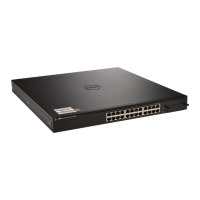Configuring Data Center Bridging Features 835
Commands
This section provides information about the commands you use to manually
configure and monitor ETS. For more information about the commands, see
the
PowerConnect 8024/8024F/8132/8132F/8164/8164F CLI Reference
Guide
at support.dell.com/manuals. On PC81xx switches, the following steps
are not required if using the DCBX protocol to obtain ETS configuration
from an auto-configuration source. PC80xx and PCM8024-k switches do not
support configuration of ETS parameters. To ensure lossless behavior, the
administrator must perform other configuration steps including creating a
non-default VLAN, configuration ports in trunk mode, enabling PFC and
assigning PFC to the lossless queue.
For information on configuring iSCSI and DCBX, refer to "Configuring
iSCSI Optimization" on page 395.
Command Purpose
classofservice traffic-
class-group
Maps the internal Traffic Class to an internal Traffic Class
Group (TCG). The Traffic Class can range from 0-6,
although the actual number of available traffic classes
depends on the platform.
traffic-class-group max-
bandwidth
Specifies the maximum transmission bandwidth limit for
each TCG as a percentage of the interface rate. Also
known as rate shaping, this has the effect of smoothing
temporary traffic bursts over time so that the transmitted
traffic rate is bound.
traffic-class-group min-
bandwidth
Specifies the minimum transmission bandwidth
guaranteed for each TCG before processing frames from
lower numbered TCGs on an interface.
traffic-class-group strict Activates the strict priority scheduler mode for each
specified TCG.
traffic-class-group
weight
Specifies the scheduling weight for each TCG. The
scheduler attempts to balance the traffic selected for
transmission from the TCGs such that, when the switch is
congested, traffic is selected from the round robin
configured TCGs in proportion to their weights.
show classofservice
traffic-class-group
Displays the Traffic Class to Traffic Class Group mapping.

